#Tiki Boat
Explore tagged Tumblr posts
Text

2 notes
·
View notes
Text

Sunset Cruise Party Boat in Fort Walton Beach, FL - (850) 888-0023
Experience an unforgettable tiki boat adventure with Tiki Cruise Destin in Fort Walton Beach, Florida. Enjoy 3-hour captained cruises to Crab Island, perfect for families and friends. Relax on Bote Floats, groove to custom sound systems, and soak up tropical vibes. Offering private cruises on 6 or 30-passenger boats, Tiki Cruise Destin ensures fun, relaxation, and scenic views. Ideal for swimming, sightseeing, and making memories. Book your tropical escape today!
Tiki Cruise Destin 10 Miracle Strip Pkwy SW, Fort Walton Beach, FL 32548, United States (850) 888-0023 https://tikicruisedestin.com
#Sunset Cruise Party Boat#fort walton beach#fort walton#florida#boat adventure#private cruises#tiki cruise destin#fl#tiki boat adventure#tiki boat#tiki cruise
0 notes
Text
2022: Branson Landing, Branson Missouri
During our Family Reunion in July 2022 in Branson, Missouri, my son and I had some time to go to the Branson Landing to explore. There are so many shopping, eating, and entertainment options at the Branson Landing that you really could spend the whole day there. It was during this day that we ate at Guy Fieri’s Kitchen and Bar that I made a scrapbook spread for earlier this week. The theme of…

View On WordPress
#Branson#Branson Landing#creative#design#fountain#ideas#Landshark#MASCrapping#masculine scrapbooking#Missouri#ScrapBook#scrapbooks for men#Tiki boat
0 notes
Text
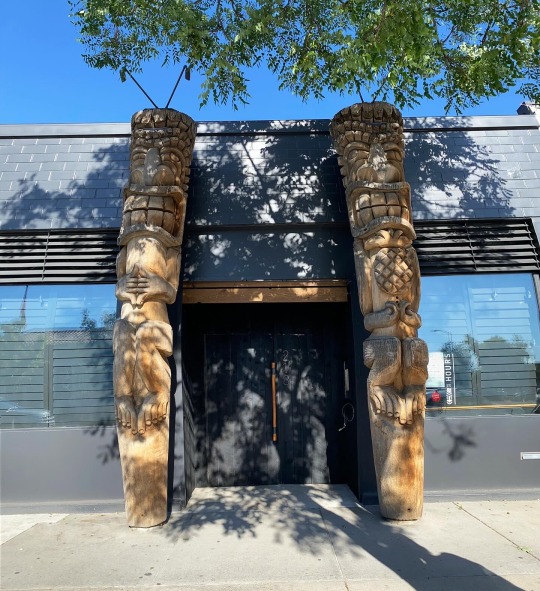
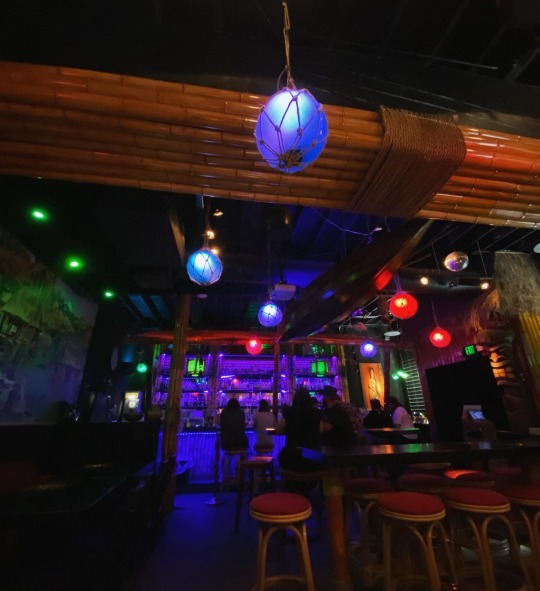
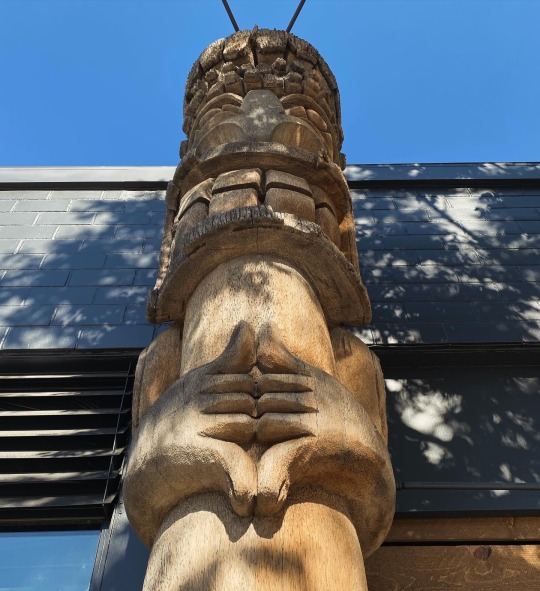

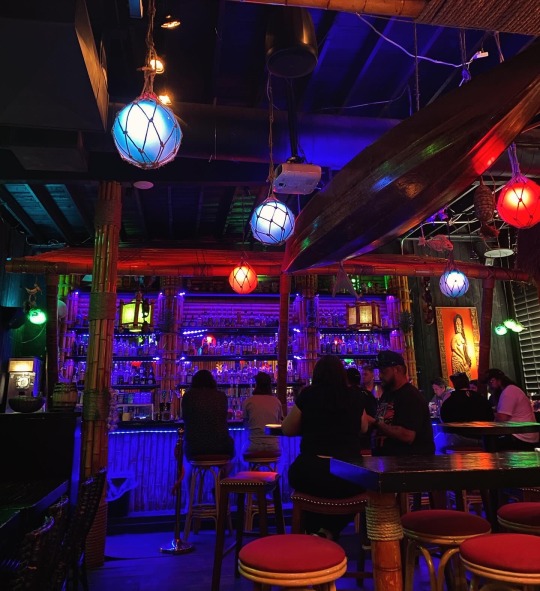
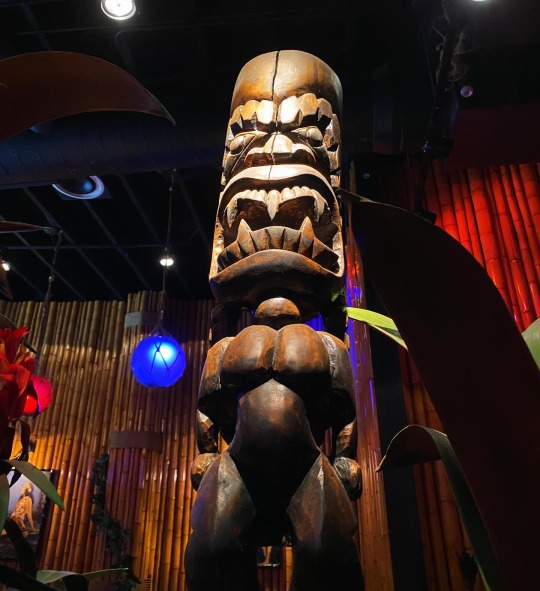
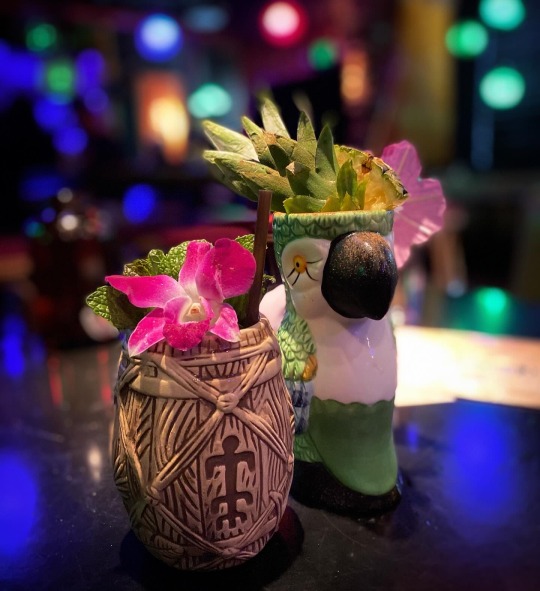
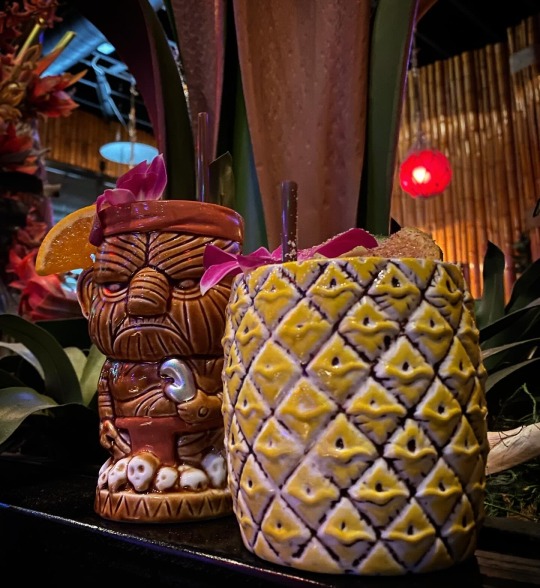
Another spot we finally got to visit on a trip to Denver was ADRIFT🗿 In contrast to Hell or High Water, ADRIFT is going for a more classic (but definitely elevated) Polynesian Pop dining experience in the vein of Trader Vic’s, and manages to do a lot with a fairly small location! The food we had was great, there was a good mix of classic tiki drinks & new school cocktails and they even served the drinks in tiki mugs, which is always a plus to me.
This spot has a two-hour visit limit & I would love to visit again, just sit at the bar & try a couple more of their cocktails! 🍹🍹🍹
#tiki#tiki bar#tiki drinks#cocktails#denver#colorado#Polynesian pop#tropical drinks#don the beachcomber#trader vic#trader sams#tiki revival#jungle river boat voyages
10 notes
·
View notes
Note
One hand turns its back to the wall, knuckles rapping against the wood; the other clutches a small cloth by its bunny-eared knot, careful not to crush its contents. She peers through the open doorway, then hops right through.
"Tiki?" A grin. "I found you!"
Truth be told, she's far from done with exploring the ship yet-- though with the way voyages go, she'll surely have ample opportunity-- but after seeing more than one passenger already green at the gills, her priorities had shifted.
"How are you feeling?" Not the first time she's asked that question, nor will it be the last, but with Tiki, she takes special care. She slides into the space next to her, holding the bundle in her two palms like one might hold any number of small gifts: rolling marbles, a cupful of rainwater, a docile frog -- how her gift measured up to these wonders would be for Tiki to decide, but she peels the cloth away like petals from a flower or rind from a citrus fruit.
"Do you want some crackers? If the ocean makes your tummy queasy, they might help you feel better." A smile. "But not too much at once, okay? Hee hee."
Sitting in her own personal cabin and pressing her face up against the glass window of the room, Tiki was staring in awe and excitement at the waves lapping at the sides of the boat that rushed through the waves, cruising at its own pace. The way the water sparkled beneath the sun shining high above looked so tempting to jump into and swim in. With her mind made up, Tiki was ready to bounce her way to the main deck of the ship and prepare for a dip into the sea below, but all thoughts of swimming fleeted her mind the moment her sister burst through the door with a polite knock.
Tiki squealed, running up to Maria and tackling the little girl with a giant hug of her own, giggles and light laughter filling the little manakete’s cabin. “Maria! I missed you so much!” Tiki rubbed her face into Maria, squeezing her sister in a warm grip before releasing Maria to allow the girl to fill her lungs with air, though Tiki merely gave her a wide innocent smile, blooming with happiness. “I am feeling great, Sis! I hope you have been too. I haven’t seen you since the big dance party! Even outside your dress, you look so cute!” The praises Tiki sung were honest and filled with so much joy, tinkling like bells.
Scrutinising Maria’s little bundle, her tail popping out behind her, wagging in curiosity. The rainbow of trinkets that were piled inside the bundle brought a sparkle to Tiki’s eyes, the little manakete’s tail perked up, high and straight as it wagged so hard it caused her bedding in the cabin to upturn. She was most excited about the docile frog that sat calmly in her palm, eyes closing slowly as it drifted off to sleep despite the whirlwind of excited children around them. “Froggy!” Tiki did her best to keep her voice down as she poked at the sleepy frog. The cup Maria offered to her was used to trickle water onto the frog, hydrating it as it drifted off.
“I love it a lot, Sis!” Wide smiles and another squeeze hug. “I am so sorry I didn’t bring any gifts though…” Her mood dropped slightly but she shook her head, recovering a smile as she nodded. “But I will do everything to help Sis Maria on this field trip!” Her intentions were pure as white.
“I don’t feel as sick, in fact I really wanted to go out and swim in the sea with the fishies! But because Sis Maria has crackers, let's share the crackers!” She giggled when they were offered, putting the sleepy frog on the cabin floor as she brought Maria to sit with her on the wooden flooring, breaking the crackers in half and munching on them as crumbs stuck to her cheeks, with restraint of course to follow Maria’s advice to not eat too many.
#~ic: tiki's turn#toasabbamvitatham2023#princessmacedon#~ooc: bolt speaks#~ooc: child with the attention span of a goldfish on a boat#~ooc: what will she do- oh my god sister hiiiii <3
5 notes
·
View notes
Text
And while storms might well have blown the occasional Chinese ship as far as America* – and the North Equatorial current could, conceivably, have brought them back again – it was never likely that eleventh-century explorers, however motivated by Renaissance spirit, would find the Americas and return to tell the story.
*Some historians believe that Xu Fu, the emissary sent by the Qin First Emperor to find the herbs of immortality, reached America's west coast in the 210s BCE. There is, however, no actual evidence, and Tim Severin's bold attempt to repeat Xu's voyage in 1993 was not encouraging – despite having many modern advantages, he had to abandon ship a good thousand miles shy of America. Nor does Thor Heyerdahl's famous balsa raft Kon-Tiki inspire confidence. Heyerdahl crossed only half the Pacific, from Peru to Polynesia, and in only one direction, carried by the Equatorial Current. The voyage from Asia to Peru is much longer and tougher.
"Why the West Rules – For Now: The patterns of history and what they reveal about the future" - Ian Morris
#book quotes#why the west rules – for now#ian morris#nonfiction#storms#chinese#ship#boat#north equatorial current#tim severin#thor heyerdahl#kon tiki#pacific ocean#11th century#renaissance#americas#motivation
1 note
·
View note
Photo

A large, modern backyard dock design example with a pergola Example of a large trendy backyard dock design with a pergola
0 notes
Photo

A large, modern backyard dock design example with a pergola Example of a large trendy backyard dock design with a pergola
0 notes
Text
The Swifties have descended upon Pittsburgh and I'm wondering if you could just like sit in a kayak on the river to listen
1 note
·
View note
Photo

A large, modern backyard dock design example with a pergola
#Example of a large trendy backyard dock design with a pergola tiki hut#pool#bar#marble pool deck#boat dock
1 note
·
View note
Text

Party Cruises in Fort Walton Beach, FL - (850) 888-0023
Experience an unforgettable tiki boat adventure with Tiki Cruise Destin in Fort Walton Beach, Florida. Enjoy 3-hour captained cruises to Crab Island, perfect for families and friends. Relax on Bote Floats, groove to custom sound systems, and soak up tropical vibes. Offering private cruises on 6 or 30-passenger boats, Tiki Cruise Destin ensures fun, relaxation, and scenic views. Ideal for swimming, sightseeing, and making memories. Book your tropical escape today!
Tiki Cruise Destin 10 Miracle Strip Pkwy SW, Fort Walton Beach, FL 32548, United States (850) 888-0023 https://tikicruisedestin.com
#Party Cruises#fort walton#fort walton beach#florida#tiki boat#boat adventure#tiki cruise destin#private cruises#fl#tiki boat adventure#tiki cruise
0 notes
Text
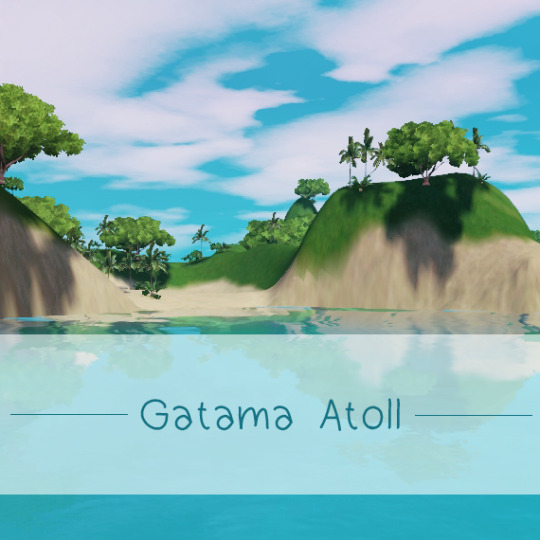

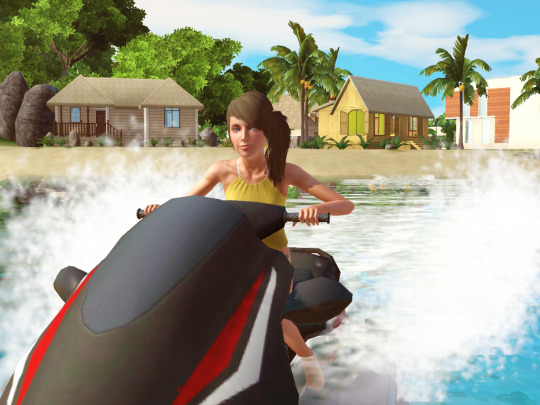
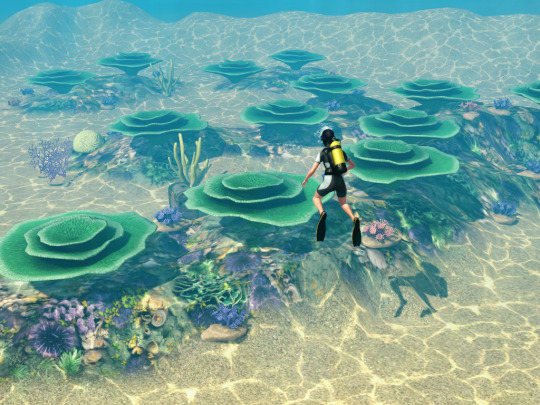
"A tropical ocean paradise loved by divers for its colorful coral and fish and more recently by scientists for its unique marine life. With plenty of large and small fish, this is an ideal diving location."
Hi, I’m Catherine and this is my first Sims 3 world! My intention was to create a smaller world that can be used to play the Island Paradise expansion pack in a more compact way. (It’s technically medium-sized, but a lot of that is water.) I based this world on the area of the same name in the game Endless Ocean: Blue World, granted with quite a lot of creative liberties taken. Gatama Atoll is situated in the fictional country of the Pelago Commonwealth, which is in Micronesia.
Isla Paradiso is stunning and there are great fixes out there, but I still prefer to play smaller worlds for the sake of performance and convenience. So here’s a small world meant for boats, houseboats, resorts, lifeguards, merfolk and of course diving!

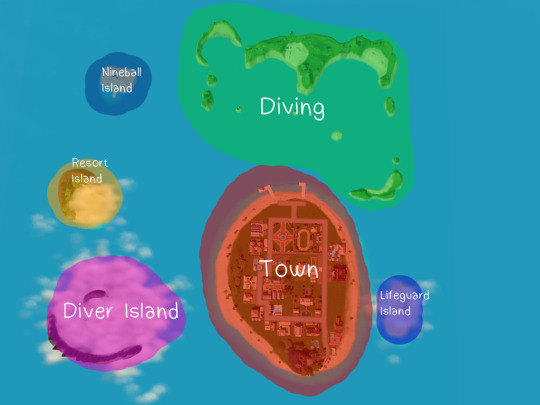
While Gatama Atoll now features a town, the original area is still for diving, with 5 dive lots based on some of the areas in the game. On the islands surrounding the dive lots are small nature areas similar to those found in the original Gatama Atoll — you can find animals here.
Nearby is Nineball Island, a relaxing and homey place, ready for divers to move in and make it their hub of operations. This is also an area from Endless Ocean: Blue World.
The town features all the base game rabbit holes as well as a few community lots and the Festival Grounds, and empty lots for expansion. Additionally, there are houses situated right near the water, and ports for houseboats. The empty 64x64 lot is intended for you to build your own resort (or place one you downloaded), though of course you can place your resort elsewhere if you wish.
Like Isla Paradiso, Gatama Atoll has mysterious islands surrounded by fog, waiting for discovery. Only a few, though; one unlocked through diving, one through resorts, and one through lifeguarding (exact way to get each island will be included below).
Gatama Atoll requires Island Paradise, Seasons, Pets, and Sunlit Tides. I specifically made this world with blam’s ea store files, as my decrapped sims3packs did not work in CAW. Therefore, I believe this means you also need the Sunlit Tides store files to be non-decrapped in order to play this world. My recommendation is to just pick them up from blam.
This world definitely isn’t perfect, considering it was made by a complete novice. Here are some disclaimers:
The landscaping is relatively simple, both because of performance concerns and because I lack skill in this area.
The only lot I made is Nineball Island + I edited the houseboat. The other lots are all from Sunlit Tides or Isla Paradiso.
The world is also definitely on the smaller side and doesn’t have room for a lot of extra lots.
Also, you need to be farther out in the ocean to snorkel, you can’t be close to the beach.
The notifications when your sim levels up their diving skill are gonna say the Isla Paradiso diving spot names (e.g "Rocky Reef"), not the Gatama Atoll diving spot names. Please refer below for a proper guide on when you can access each diving spot.
This world was made in version 1.67 (Steam)
Required mods
NRaas register - with this mod, ban horses, unicorns, paparazzi and deer for a smoother experience. You don't want that stuff in this world.
Dive cave reset fix - I used one and only one dive cave in this world. With this mod, you need to reset that dive cave when you see it, just once. Please do not forget to reset the cave so that your sim doesn't get reset when trying to enter.
Interact on sloped terrain - The world is kinda curvy so I think having this is a good idea.
Recommended additions
Surf’s Up Sun and Fun Collection - so your sim can surf, and also have some cute CAS stuff.
Sun, Surf and Sand - cute beachy buildbuy stuff.
Island Villa - ditto^
Tiki dining room - tiki buildbuy stuff
Tiki living room - ditto^
Tiki outdoor living - ditto^
Yoga mod by twinsimming - for the tropical paradise zen.
Mermaid Power mod by xantak22 - improves mermaid gameplay.
4t3 Island Living conversions - look around for some if you need more buildbuy or clothes.
Feel free to do whatever you want with this world! I have no conditions. You’re welcome to tag me so I can see, too :)
Download 🐠
Notes
Here is when each dive spot is unlocked:
Atoll Gate: available at level 2 of the diving skill
Spring Garden: available at level 4 of the diving skill
Doughnut Reef: Available at level 6 of the diving skill
Blue Cliff: Available at level 8 of the diving skill
Cabbage Patch: Available at level 10 of the diving skill
Here is how to get each hidden island:
Diving island: At level 10 of the diving skill, explore the cave in Cabbage Patch. Reset the cave before going in.
Lifeguard island: Rescue 35 sims as a lifeguard.
Resort island: Have a 5-star resort.
#the sims#s3cc#sims 3 world#sims 3 caw#endless ocean#endless ocean blue world#sims 3 cc#sims 3 download#sims 3#sims
213 notes
·
View notes
Text
Out and about in SF with our youngest set of nieces (one of whom snapped this pic).
The Hot Wife loves tiki bars and cocktails. We always hit the Tonga Room when we’re in town. It’s been in operation since 1945 and is one of the few surviving examples of high tiki style. Gorgeous interior, a pool with a boat (where the band plays), and rain that occasionally falls from the ceiling into the pool accompanied by thunder. Tiki bars usually have creative mocktails too. 😁

#our weekend started early#Tonga Room#tiki bar#cocktails#butch#dyke#wlw#lesbian#queer#wives#happily married
143 notes
·
View notes
Text
Fossil Crocs of 2023
2023 has been a year with its ups and downs, but one consistent thing has been its fossil crocs at least, giving us another interesting variety of species and genera not known before. Like last year, I'll go down each of them (including phytosaurs) and give you some key notes. And since I've done my best to make individual posts for them I'll link those when available. I'll also try to give translations where possible, but do note that sometimes I might switch around a word due to it just sounding awkward otherwise.
Scolotosuchus
Starting us off is Scolotosuchus basileus ("royal scythian crocodile"), a basal, rauisuchian-like animal from the early stages of the Triassic. An animal roughly 3 meters long, it is primarily known from vertebrae and some other material, which however does have interesting implications. Based on the anatomy of the vertebrae, it has been speculated that Scolotosuchus performed a lot of rapid movement of the neck, presumably while hunting. Furthermore, it might be that Scolotosuchus lacked osteoderms, instead having developed a bracing system for its body much more like that of dinosaurs and mammals. Artwork by @knuppitalism-with-ue (he'll pop up quite a lot)
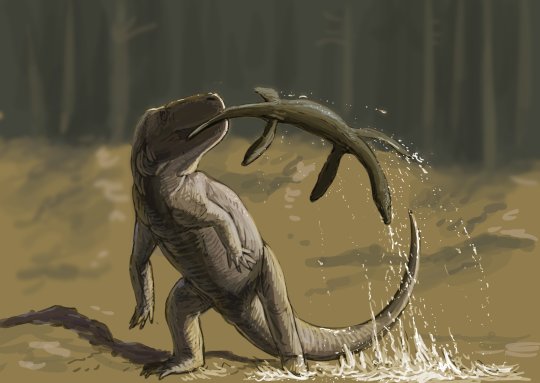
Colossosuchus
Fast forward to the Late Triassic, the hayday of early Pseudosuchians, and we find our first phytosaur of the list. Colossosuchus techniensis ("colossal crocodile of the Indian Institute of Technology") was an enormous animal from India's Tiki Formation. This one is known from undisputably better material, perhaps some of the best on this list as we have an entire bone bed of these guys, possibly representing a mass death site. Size estimates of the large specimens generally range from 6 to 9 meters in length, also making it the largest animal of this list, with the authors favoring an estimated 8 meters for the largest individual. Of course this is all subject to change, as we don't know the precise proportions (the downside of a bone bed is that all the bones are kinda jumbled together and god knows what belongs to what). Artwork by Joschua Knüppe again, a female being courted by an overconfident and confused Volcanosuchus (told you so)

Kryphioparma
Ok I won't bother you with this one too much. Kryphioparma caerula ("blue mysterious shield") is an aetosaur from the Late Triassic Chinle Formation of Arizona. Now aetosaurs are cool of course, but the thing is that Kryphioparma is known from exclusively osteoderms, their large armour plates. While thats valid, its also not really exciting (as you could have guessed from the absolute lack of artwork). Best I can say is that it coexisted with a bunch of other aetosaurs, which surely would have been a sight to see back in the day.
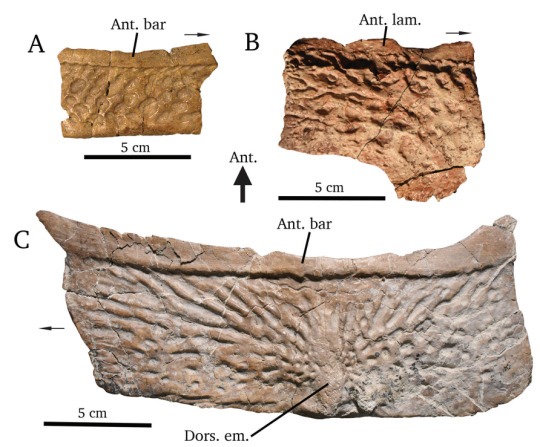
Venkatasuchus
Now Venkatasuchus armatum ("Venkata's armoured crocodile") is in a similar boat. This Indian aetosaur too is only known from osteoderms, tho at least a lot more of them that were found together, meaning we got a much better idea of its shape. There are some interesting implications it has on paleogeography and how different animal groups spread across Pangea, but that's probably beyond the scope of this post. There is at least some art of it tho, including one piece by Joschua featuring Jaklapallisaurus, an early sauropodomorph.
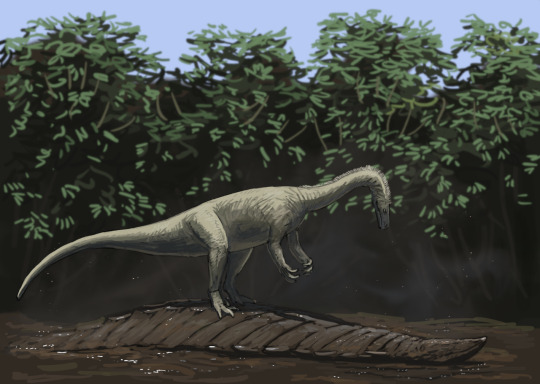
Mystriosuchus alleroq
Now we got our first new species of a preexisting genus. While I did my best to make posts on new genera, which typically went hand in hand with their respective wikipedia pages, species are a different matter since they'd require me to overhaul and research the whole genus. Which for Mystriosuchus would go all the way back to 1896.
Anyhow, Mystriosuchus alleroq ("jawbone spoon crocodile") is the newest in a long line of Mystriosuchus species and has been recovered from western Greenland of all places. Like Colossosuchus it is known from multiple individuals, at least four in fact, And like Venkatasuchus, it appears to have wideraning implications for the spread of archosaurs during the Triassic. Oh look its Josch's art again, neat.
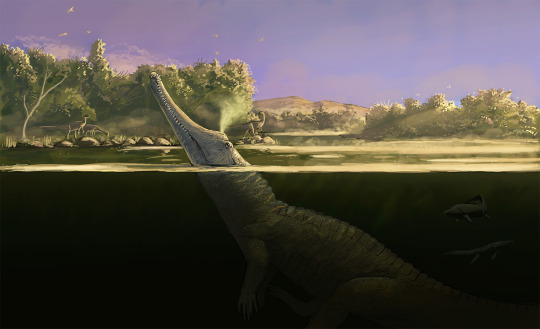
Jupijkam
The final phytosaur and the final Triassic taxon of the year, Jupijkam paleofluvialis ("horned serpent of ancient rivers") was recovered from Nova Scotia Canada and represents one of the northernmost phytosaurs (alongside obviously our friend Mystriosuchus alleroq above). It is far less complete than the other phytosaurs I covered so far, but still nothing to scoff at. It's also one of the youngest known phytosaurs, possibly having lived during the last stage of the Triassic. There's no art but here's an image of its snout from the original paper.

Turnersuchus
And with this we have reached the Jurassic and somewhat of a double feature. Ordering these via chronology makes this almost like storytelling. Turnersuchus hingleyae ("Hingley's and Turner's crocodile") is the oldest and basalmost named thalattosuchian, a group of crocodylomorphs that took to the seas. As such it shows a mosaic of features, already having begun to reduce its limbs, having a moderately long snout and still bearing osteoderms, which some of its descendents would come to lose. Turnersuchus dates to the Pliensbachian, a stage of the early Jurassic, tho the paper mentions how its not likely to hold its title as oldest member of its group for long as even older material has been discovered and is awaiting publication. Artwork by Júlia d’Oliveira and Joschua Knüppe

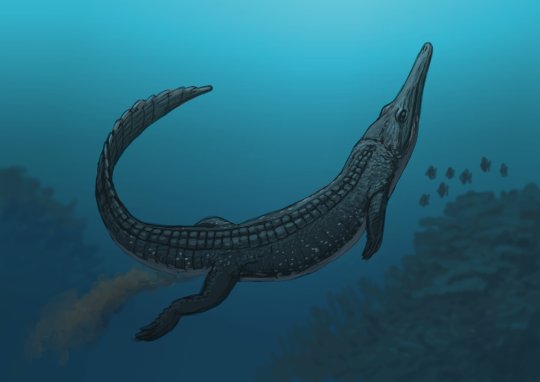
Torvoneustes jurensis
While Turnersuchus gives us a glimpse at what the earliest thalattosuchians were like, Torvoneustes jurensis ("savage swimmer of the Jura Mountains") represents them at one of their most derived. At 4 meters long, it must have been an impressive creature, entirely smooth and lacking osteoderms, highly reduced arms and a tail fluke to boot. There are some interesting features, as unlike other species of Torvoneustes, this one does not appear to have been as durophagous, instead appearing to be more of a generalist. It's the last Jurassic croc of the year and practically lived at the opposite end of this time period relative to our previous thalattosuchian, during the Kimmeridgian. Artwork by Sophie De Sousa Oliveira, not to be confused with Jùlia who drew Turnersuchus.
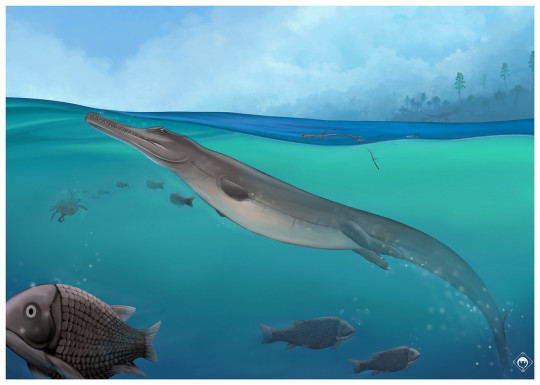
Comahuesuchus bonapartei
From marine to terrestrial, Comahuesuchus bonapartei is a member of the Notosuchia, land-dwelling cousins to the Neosuchia. This new species is known from the Cretaceous of Argentina and was described on the basis of a lower jaw, which differs from the previously described species of Comahuesuchus by the fact that the teeth are situated in individual sockets. Its jaws were short and wide, being described as U-shaped, giving it a somewhat pug-nosed appearance. In case you're wondering why I don't have the translation of the name thats because I can't access Bonaparte's first paper, so all I can say is that the new species is named after famed Argentinian paleontologist Jóse Fernando Bonaparte. Artwork by I mean you probably guessed it, its Josch again.
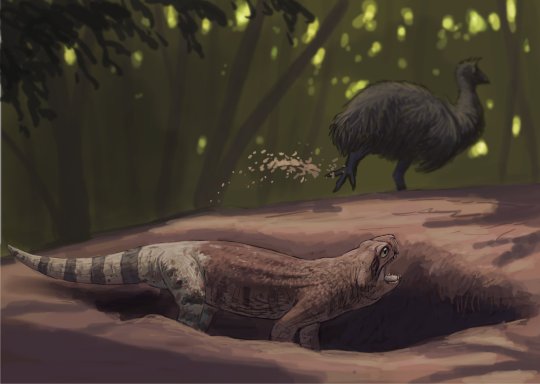
Aphaurosuchus kaiju
I have some mixed feelings on Aphaurosuchus kaiju ("powerless kaiju crocodile"), not just because I have to rewrite its genus wikipedia page that I am no longer happy with. No, Aphaurosuchus is a great genus in my opinion, given the complete nature of the holotype. But I do think that the species name of this second form is a bit of an exaggeration, seeing as it is to my knowledge not that exceptionally big. So why name it kaiju other than to sound cool? I also think it just kinda becoms funny when you consider the meaning of the genus name. Anyhow, it does look pretty mean, but thats to be expected from a baurusuchid. It lived during the Late Cretaceous in Brazil and the phylogenetic analysis that accompanied its description had some interesting implications that I'm curious to see tackled in the future. Other than that it's just another baurusuchid from a place crawling with baurusuchids, which tbh is pretty cool itself but doesn't really help make it stand out. Arwork by Paula Zeinner
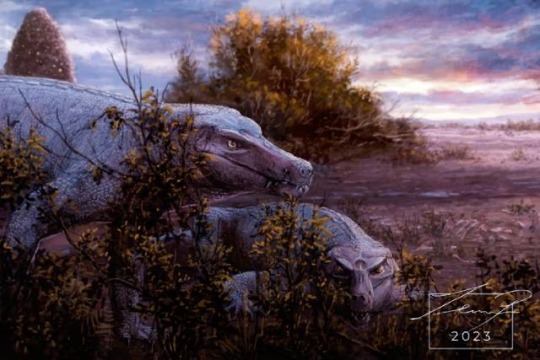
Dentaneosuchus
It is the middle Eocene. France is entirely occupied by mammals. Well, not entirely... One indomitable reptile still holds out against the invaders. Yes, I am of course talking about Dentaneosuchus ("frightfull crocodile"), the titan of the Eocene, the terror of the jungle. Easily among the most exciting finds, this animal was an enormous sebecid previously thought to be a member of the genus Iberosuchus, but recent research not only shows its distinct but enormous. With a lower jaw around 90 cm long, it rivals even the famed Barinasuchus of Miocene South America. The total body lenght is of course a matter of debate given how little we know about sebecid proportions, with the paper lowballing it at 3 to 4 meters and I personally recovering something more akin to 5 meters. Regardless of the specifics, this would make it easily one of the top predators of its time, tho sadly this was not meant to last. It was among the last non-mammalian apex predators of Europe, before climate change and competition from mammals eventually drove them to extinction. Arwork by Joschua Knüppe and @mariolanzas


Baru iylwenpeny
Our last three entries were all members of the Notosuchia, the terrestrial crocodiles that existed from the Jurassic to the Miocene, so lets jump to the other major group of the time, the Neosuchians, specifically their most recent branch, the Crocodilians. Yes finally we are getting to crocs in the stricter sense.
Baru iylwenpeny ("divine crocodile thats good at hunting") is an animal we also knew for a while under the informal name Alcoota Baru based on where it was found. This year I spent a lot of time writing in the Mekosuchinae, Australasian crocodiles of the Cenozoic and just when I had finished the page for Baru, this guy got published. It's the largest, most robust and most recent member of the genus. Good at hunting is a good choice for the species name, as this animal was over 4 meters long with a head commonly likened to a cleaver and a hunting style speculated to consist of inflicting a lot of trauma on its prey with its massive teeth. I could gush about Baru for ages, but thats the important parts. It lived in central Australia during the Miocene only 8 million years ago. Artwork by the incredible @manusuchus
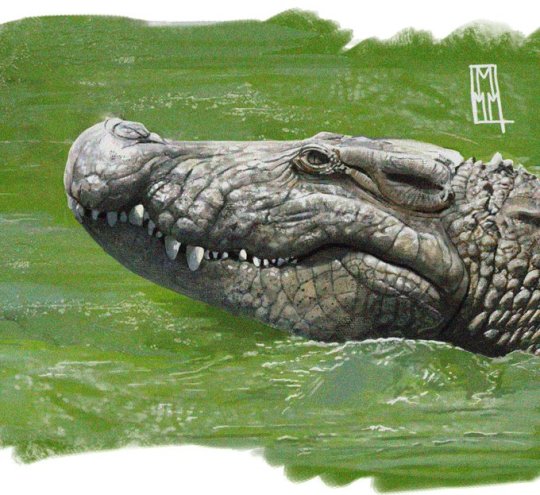
Antecrocodylus
Now for the last crocodilian described this year and one I remised to make a dedicated post for due to time constraints (I had a busy few months). Antecrocodylus chiangmuanensis ("before Crocodylus from Chiang Muan") is a close relative of the modern dwarf and true crocodiles from the Miocene of Thailand. It is only known from the back of the skull and an associated lower jaw, but it serves to highlight how little we know about the crocodiless of eastern Asia during the Miocene, which is a shame given that this region is crucial to deciphering where true crocodiles originated.
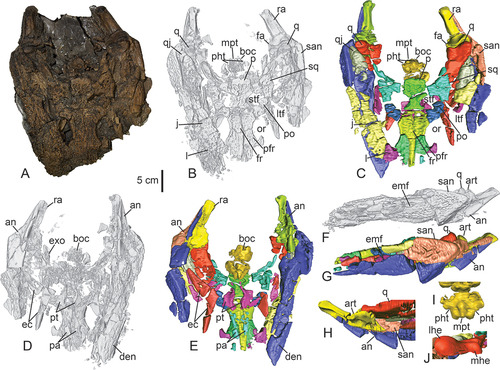
Alligator munensis
And our final taxon is Alligator munensis ("Mun river alligator"), which, obviously, is a member of the modern genus Alligator and thus most closely related to the still extant Chinese and American Alligator. Likely having been split from its Chinese relatives when the Tibetan plateau was lifted up, this species lived during the middle Pleistocene in Thailand and may have survived until the Holocene. It's head was short and robust and its teeth globular, which could indicate that it fed on hard-shelled prey like clams and snails. It was also small, likely not much bigger than 1.5 meters. Artwork by Joschua Knüppe


And that should be all of them, all new species and genera of Pseudosuchians described this past year. It's once again been fun to look back and I hope that you find them just as interesting as I do. Lets hope that 2024 will bring equally fascinating discoveries.
#alligator munensis#alligator#croc#crocodile#pseudosuchia#notosuchia#crocodilia#crocodylus#antecrocodylus#thalattosuchia#torvoneustes#paleontologoy#torvoneustes jurensis#turnersuchus#comahuesuchus#aphaurosuchus#aphaurosuchus kaiju#dentaneosuchus#jupijkam#colossosuchus#palaeoblr#prehistory#kryphioparma#venkatasuchus#mystriosuchus#scolotosuchus#baru#baru iylwenpeny#science
266 notes
·
View notes
Photo
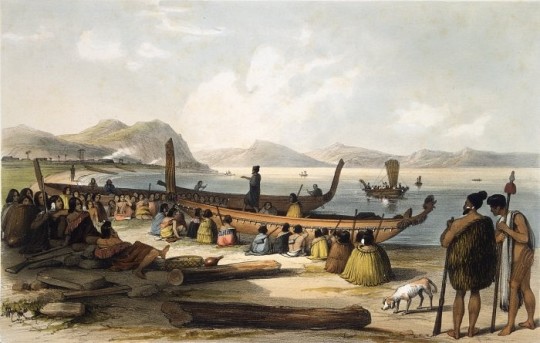
Polynesian Navigation & Settlement of the Pacific
Polynesian navigation of the Pacific Ocean and its settlement began thousands of years ago. The inhabitants of the Pacific islands had been voyaging across vast expanses of ocean water sailing in double canoes or outriggers using nothing more than their knowledge of the stars and observations of sea and wind patterns to guide them.
The Pacific Ocean is one-third of the earth's surface and its remote islands were the last to be reached by humans. These islands are scattered across an ocean that covers 165.25 million square kilometres (63.8 million square miles). The ancestors of the Polynesians, the Lapita people, set out from Taiwan and settled Remote Oceania between 1100-900 BCE, although there is evidence of Lapita settlements in the Bismarck Archipelago as early as 2000 BCE. The Lapita and their ancestors were skilled seafarers who memorised navigational instructions and passed their knowledge down through folklore, cultural heroes, and simple oral stories.
The Polynesian's highly developed navigation system impressed the first European explorers of the Pacific and since then scholars have been debating several questions:
was the migration and settlement of the Pacific islands and into Remote Oceania accidental or intentional?
what were the specific maritime and navigational skills of these ancient seafarers?
why has a large body of indigenous navigational knowledge been lost and what can be done to preserve what remains?
what type of sailing vessels and sails were used to cross an open ocean?
Ancient Voyaging & Settlement of the Pacific
By at least 10,000 years ago, humans had migrated to most of the habitable lands that could be reached on foot. What remained was the last frontier – the myriad islands of the Pacific Ocean that required boat technology and navigational methods be developed that were capable of long-range ocean voyaging. Near Oceania, which consists of mainland New Guinea and its surrounding islands, the Bismarck Archipelago, the Admiralty Islands, and the Solomon Islands was settled in an out-of-Africa migration c. 50,000 years ago during the Pleistocene period. These first settlers of the Pacific are the ancestors of Melanesians and Australian Aboriginals. The small distances between the islands in Near Oceania meant that people could island-hop using rudimentary ocean-going craft.
The so-called second wave of migration into Remote Oceania has been an intensely debated scholarly topic. Remote Oceania is the islands to the east of the Solomon Islands group such as Vanuatu, Fiji, Tonga, Aotearoa (New Zealand), Society Islands, Easter Island, and the Marquesas. What is debated is the origins of the first people who settled in this region between 1500-1300 BCE, although there is general agreement that the ancestral homeland was Taiwan. A dissenting view has been that of Norwegian adventurer Thor Heyerdahl (1914-2002 CE) who set out in 1947 CE on a balsa raft called Kon-Tiki that he hoped would prove a South American origin for Pacific islanders. Archaeological and DNA evidence, however, points strongly to a southeast Asian origin and seafarers who spoke a related group of languages known as Austronesian who reached Fiji in 1300 BCE and Samoa c. 1100 BCE. All modern Polynesian languages belong to the Austronesian language family.
Collectively, these people are called the Lapita and were the ancestors of the Polynesians, including Maori, although archaeologists use the term Lapita Cultural Complex because the Lapita were not a homogenous group. They were, however, skilled seafarers who introduced outriggers and double canoes, which made longer voyages across the Pacific possible, and their distinctive pottery – Lapita ware – appeared in the Bismarck Archipelago as early as 2000 BCE. Lapita pottery included bowls and dishes with complex geometric patterns impressed into clay by small toothed stamps.
Between c. 1100-900 BCE, there was a rapid expansion of Lapita culture in a south-east direction across the Pacific, and this raises the question of intentional migration.
Continue reading...
51 notes
·
View notes
Text
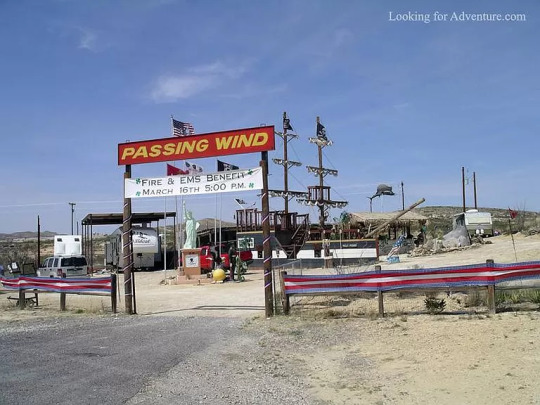
Who would like to own a property that's name literally translates to "Fart?" The late owner was a retired, decorated Viet Nam navy veteran from Brooklyn, NYC, who fell in love with the Terlingua, TX Ghost Town. The property is up for sale for $1.3M.

Every year he had a fundraiser to benefit the Fire Department and the EMS, called The Rocket Fuel Party.
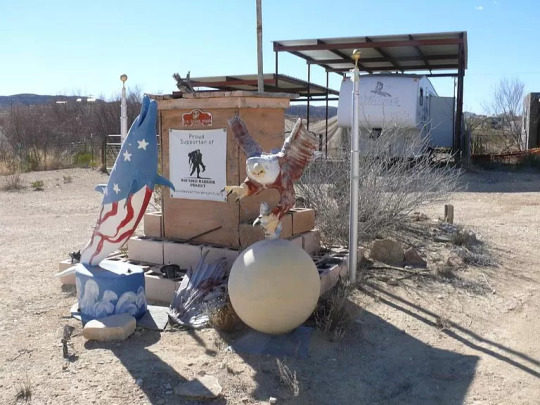
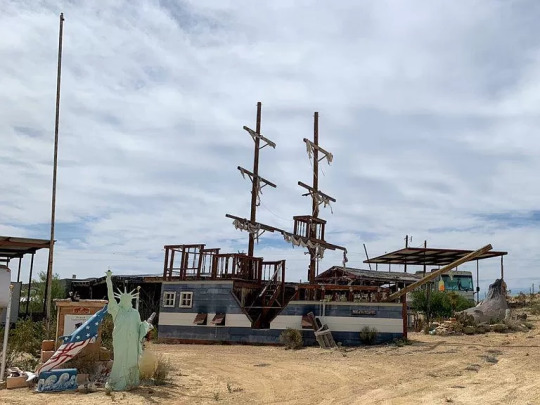
Inside the fence is a full-size conning tower of a submarine, a replica of a sailing ship, and a small Statue of Liberty that lights up at night.


The owner's name was Jimmy and he began building a fleet.

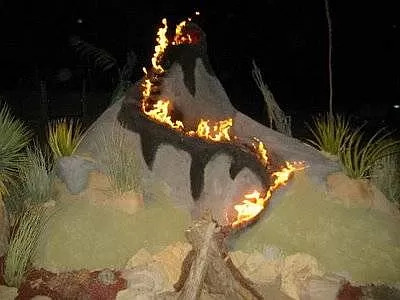
He also built a propane-powered volcano and tiki bar to complete the south seas feel.
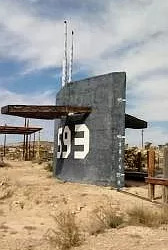


The submarine USS Thresher (SSN-593) was the lead boat of her class of nuclear-powered attack submarines in the United States Navy. She was the U.S. Navy's second submarine to be named after the thresher shark. On 10 April 1963, Thresher sank during deep-diving tests about 350 km (220 mi) east of Cape Cod, Massachusetts, killing all 129 crew and shipyard personnel aboard.

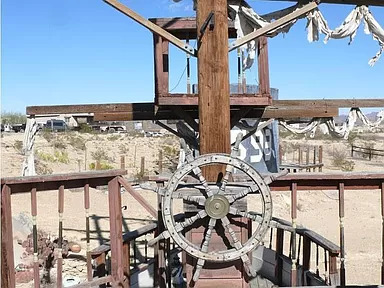
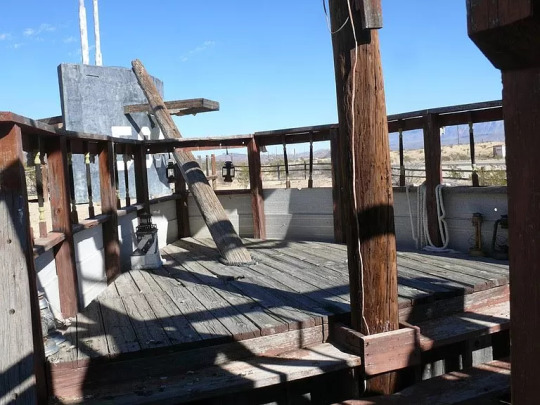
That's most of the history of Passing Wind.
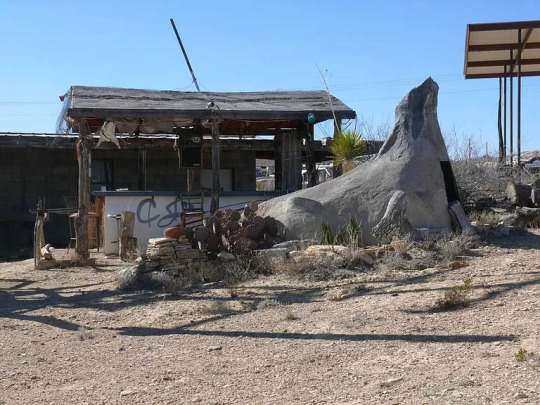
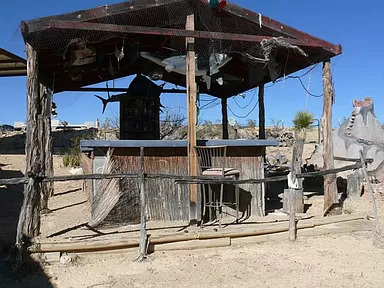
The property has fallen into disrepair and needs a new owner to bring it back to life. This is the closest structure that I can see that looks like it was the tiki bar.
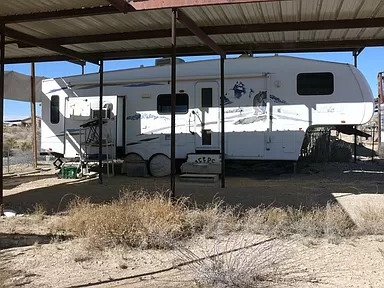
Here's the trailer Jimmy must've lived in. It looks to be in good shape from the outside.
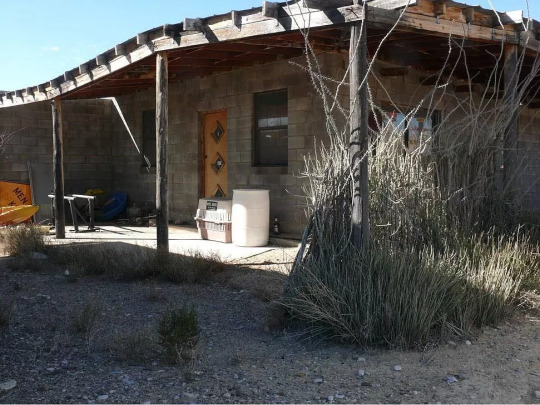
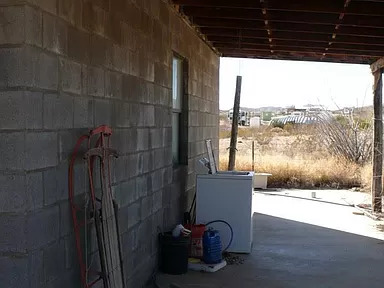
And, there's also this building.
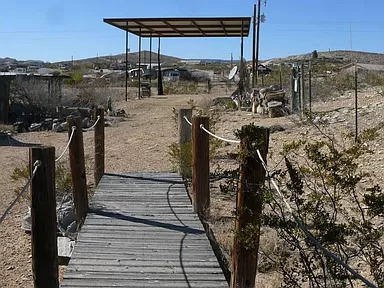
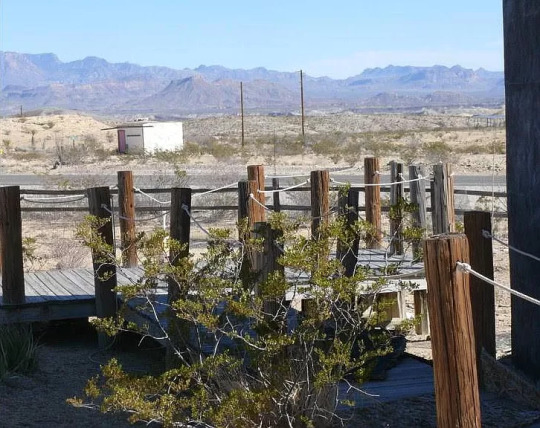
The land is 3.44 acres. I guess the new owner would have to be interested in military history enough to want to invest in making an attraction dedicated to it. I have no idea if this would be a tourist destination.
https://www.zillow.com/homedetails/Highway-170-170-Terlingua-TX-79852/2054487857_zpid/?
54 notes
·
View notes